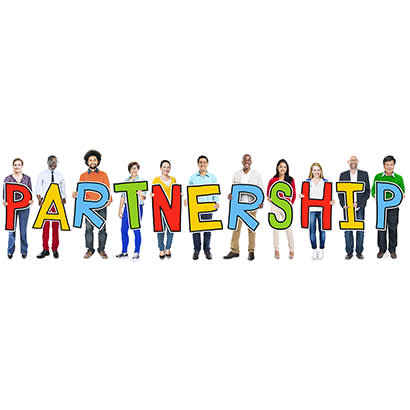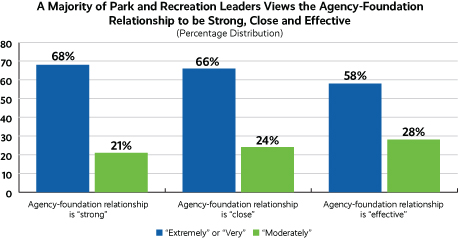
For an enhanced digital experience, read this story in the ezine.
Learn what makes a park and recreation agency-foundation relationship effective to maximize the benefits of these valuable partnerships
Parks and recreation is an essential local government service. Park and recreation professionals and their agencies deliver vital services, programming and amenities that millions of people enjoy every day, often at little or no direct cost. Well-funded park and recreation services advance community health and well-being, better prepare communities for the impacts of a changing climate and help ensure equitable access to the wide-ranging benefits of recreation. Studies conducted by NRPA and others have consistently demonstrated strong support from both officials and the general public for their local park and recreation agency.
Despite this broad base of support, park and recreation professionals often find themselves jockeying for limited tax revenue with other local government services, including public safety, education, transportation and social services. Unfortunately, parks and recreation consistently loses out in these head-to-head competitions, historically receiving only about 2 percent to 3 percent of total local government expenditures on average.
In a nod to this reality, local public park and recreation agencies often must seek funding from other sources. One approach taken by many agencies is to partner with nonprofit park foundations or “friends groups.” Although such partnerships have a long history in the delivery of local park and recreation services, they may be more necessary than ever in light of the budgetary and staffing issues brought on by the Great Recession and the global coronavirus (COVID-19) pandemic.
Until now, there has been a lack of research on the characteristics and conditions that lead to effective and sustainable partnerships between park and recreation agencies and their nonprofit partners. As a result, we worked with NRPA on a nationwide study of agency-foundation relationships that combined a survey of park and recreation agency leaders and in-depth interviews of leaders from both agencies and nonprofit foundations. The data gathered by this process generated not only a snapshot of the agency-foundation relationship, but also serves as the basis of recommendations we make for agencies hoping to get the most out of their partnerships.
Snapshot of the Agency-Foundation Relationship
Overall, about 40 percent of agency leaders report that their agency benefits from the support of a park-specific foundation. Compared to municipalities without a park-specific foundation, agencies with a park-specific foundation serve a larger average population (302,000 vs. 120,000) and manage:
- More acreage on average (6,100 acres vs. 1,300 acres)
- More parks and recreation facilities on average (46 facilities vs. 24 facilities)
- A greater average annual budget ($14 million vs. $7 million)
Most park and recreation leaders view the agency-foundation relationship positively. The majority of respondents see the relationship as “very” or “extremely” strong (68 percent), close (66 percent) and effective (58 percent).

Recommendations for Maximizing the Agency-Foundation Relationship
Fundraise (and more)
Park and recreation leaders are most likely to see the agency-foundation relationship in terms of fundraising, perhaps unsurprisingly given many agencies’ never-ending budgetary challenges. Seventy-three percent of survey respondents say that their foundation is a “very” or “extremely” important partner in this regard.
However, park foundations can be much more than just an agency’s fundraising arm. To get the most from this partnership, we recommend park and recreation leaders work with their park foundation to find areas to contribute beyond direct financial support. Some of the other roles in which park and recreation leaders see their foundation as a “very” or “extremely” important partner include:
- Special events (35 percent)
- Capital construction projects (28 percent)
- Parkland or Facility acquisition (27 percent)
- Marketing (24 percent)
- Lobbying/Advocacy and Political activity (24 percent)
Lean into flexibility and versatility.
As a nonprofit (and non-governmental) organization, park foundations have greater flexibility at an institutional level. For example, park foundations may have significant leeway in terms of how they fundraise, where to allocate the funds and how quickly to take action. Park and recreation leaders should make use of that flexibility whenever possible and work with foundations to envision creative strategies that address outstanding issues in ways that public agencies cannot.
In describing this characteristic flexibility, one park and recreation agency leader shared with us how their foundation collaborates with a local craft brewery and local apiarists (beekeepers) to brew a beer using honey collected from honeybee hives in the parks. A portion of the proceeds fund park-related causes in partnership with the local agency. Interviewees related a variety of examples like this one, emphasizing the importance of encouraging outside-the-box thinking from foundation partners.
Park foundations can serve as a source of knowledge, skills and connection not necessarily present in a local agency. For example, people who volunteer to serve at park foundations come from all walks of life. Tap into that knowledge base when appropriate — maybe a board member comes from a financial or legal background, or perhaps someone has a connection with an influential local leader who can bridge prior community engagement gaps.
Communication is key.
Communication is critical to the success of the agency-foundation relationship in many ways. Part of the communication equation has to do with frequency: agency leaders who report more frequent communication with their foundation are more likely to enjoy better and more effective relationships with their agencies’ foundations.
We note that frequent communication is not, by itself, enough. Both agency and foundation leaders stress the need for purposeful communication that is focused on aligning long-term goals and objectives, as well as day-to-day operations. An overwhelming majority of agency leaders also note that the ability to communicate (verbally and through writing) and listen is a key skill for them and their peers.
Build relationships.
Directly related to the idea of communication, both agency and foundation leaders emphasize the importance of building strong interpersonal relationships across organizational boundaries. Several leaders note that having a close connection with the leadership at their partner organization has been a critical factor in the success of the agency-foundation relationship. Conversely, hostile relationships between the organizations’ leadership often undermine these partnerships (and the goals of both entities).
Healthy relationships must go beyond just an agency’s and foundation’s leader. Building a culture where the staff at both organizations are able to work together in a cordial, professional and productive fashion is just as necessary. Strong organizational ties have the bonus of sustainability: a robust organizational relationship is likely to outlive the retirement of one or more key figures.
Formalize ties.
A common feature of many highly successful agency-foundation partnerships is a formalized agreement or memorandum of understanding (MOU). An MOU between an agency and its foundation establishes clear roles and responsibilities for both partners, encouraging close collaboration and alignment on funding priorities. Survey respondents noted each of these characteristics as essential features of the agency-foundation relationship.
A more formalized agreement also can help avoid many of the potential pitfalls of agency-foundation relationships. Leaders point out that an MOU can help mitigate the risk of conflicts about funding priorities, reduce confusion over the proper process for a project or decrease the number of missed opportunities in the community.
Engage with the community.
Successful agency-foundation relationships benefit from an engaged public. Park and recreation agency leaders report in our survey that community trust in the agency and community trust in the foundation are essential features of the agency-foundation relationship. Successful public-
engagement surrounding the agency-foundation relationship will not only help build familiarity and trust, but also can build awareness regarding the need for donations, volunteers and other park-related causes.
Having a frequent and open dialogue with the public also allows park and recreation agency leaders to develop a deeper understanding of the community that they serve. There are no one-size-fits-all solutions in community projects. Cultivating engagement with the public promotes an enhanced community-specific cultural knowledge that results in better outcomes.
Focus on equity.
One of the greatest challenges agency and foundation leaders note is an ability to equitably deliver the benefits of the agency-foundation relationship to all corners of the community. For many interviewees, equity emerges as the chief missed opportunity for the agency-foundation relationship, a priority that leaders on both sides of these partnerships want to address.
One specific issue related to equity is ensuring foundation-funded projects address issues beyond more affluent communities. Agency and foundation leaders speak of both the importance and difficulty of working to fund projects where residents are less affluent, less capable of advocating for themselves, or less likely to donate to a park foundation. Leaders of both organizations must proactively work to overcome an “only in my backyard” mentality to ensure these relationships foster equitable access to high-quality park and recreation amenities and services.
Make the Agency-Foundation Relationship a Priority
Although park foundations have long been a valuable partner to many public park and recreation agencies, their importance may only grow in light of the global pandemic and resulting recession. For agencies currently partnering with a foundation, maximizing the potential benefits of that relationship will be critical to ensuring the ongoing delivery of high-quality park and recreation services to the community.
Even more critical is for agencies that do not currently engage in this type of partnerships to explore the development of a park-focused foundation to help navigate these challenging times. Begin by reaching out to key stakeholders within the community, your peers at nearby agencies or existing community foundations. While an excellent agency-foundation relationship will not develop overnight and the task may seem daunting, as the Chinese philosopher Lao Tzu once said, “A journey of a thousand miles begins with a single step.”
Nick Pitas, Ph.D., is Assistant Professor of Recreation Management at the State University of New York-Brockport (npitas@brockport.edu). Andrew Mowen, Ph.D., is Professor of Recreation, Park and Tourism Management at the Pennsylvania State University (amowen@psu.edu). Samantha Powers, MS, is a Ph.D. candidate in Recreation, Park and Tourism Management at the Pennsylvania State University (sammie.powers@psu.edu).

